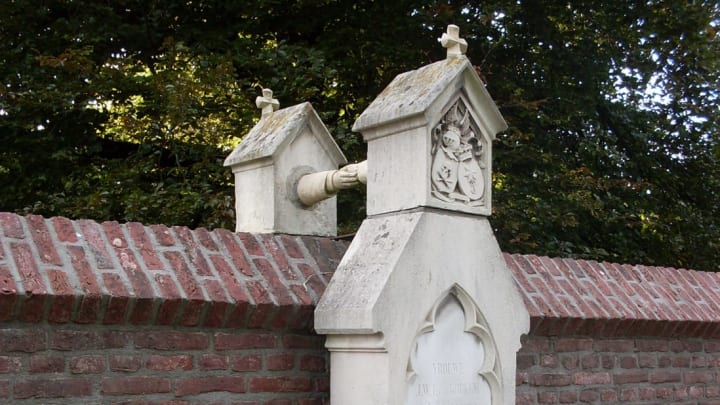Established in 1785, Het Oude Kerkhof in Roermond, the Netherlands, is one of the oldest municipal cemeteries in the country—and it's home to a pair of graves that use a crafty design to prove love can conquer anything.
As author Loren Rhoads explains in her new book 199 Cemeteries to See Before You Die, in 1842 a 22-year-old Catholic noblewoman named J.C.P.H. van Aefferden fell in love with a 33-year-old commoner named J.W.C. van Gorkhum, a colonel in the Dutch cavalry who happened to be Protestant. Their marriage was a local scandal, but the pair stayed together for 40 years. Their union only ended with van Gorkhum's death in 1880, and even then, van Aefferden made sure they wouldn't be totally separated.
At the time, plots in Het Oude Kerkhof ("The Old Cemetery" in Dutch) were strictly divided into Catholic, Protestant, and Jewish sections, with borders maintained by thick hedges or brick walls. As a Protestant, van Gorkhum couldn't be buried in the van Aefferden family plot in the Catholic section, where she was supposed to spend eternity.

The devoted wife got around the predicament by ordering a unique pair of grave markers—two tall white monuments that stretch above the brick wall separating the Catholic and Protestant sections. From each monument, a white hand (one masculine, the other feminine) reaches out to grasp the other, their fingers locked for eternity.
Colonel van Gorkhum was buried beneath the grave with the masculine hand, at the edge of the Protestant section, and when his wife died eight years later, she was laid to rest beneath the grave with the feminine hand, at the edge of the Catholic section.

Nearly 130 years later, tourists flock to the graves, which are known locally as Het graf met de handjes, or “Grave with the little hands.” It's a beautiful reminder that when there's a will, love tends to find a way.
